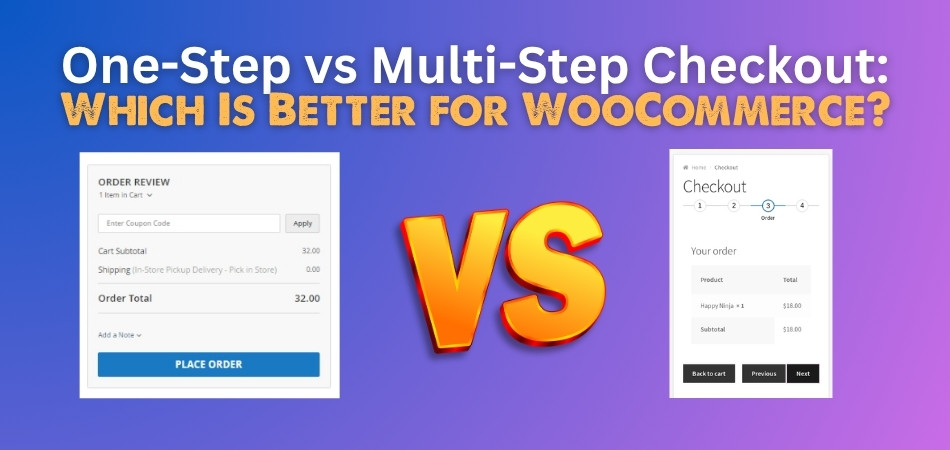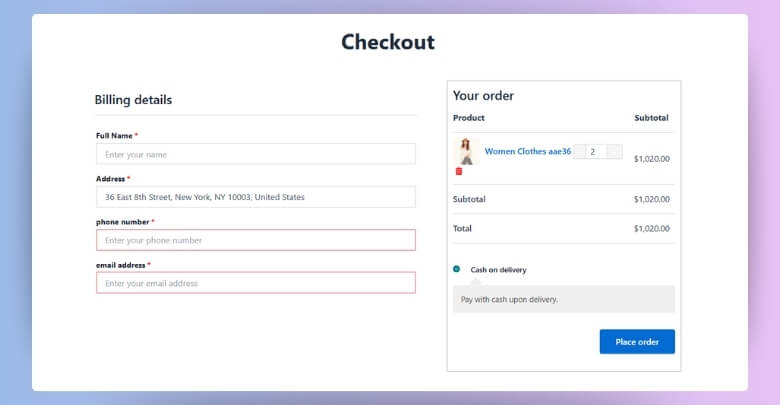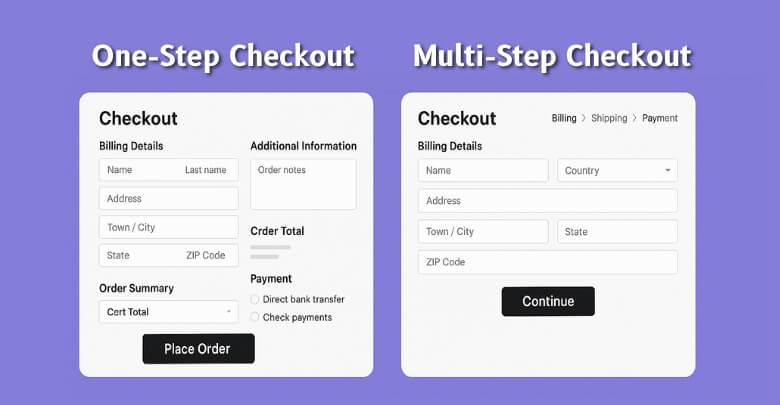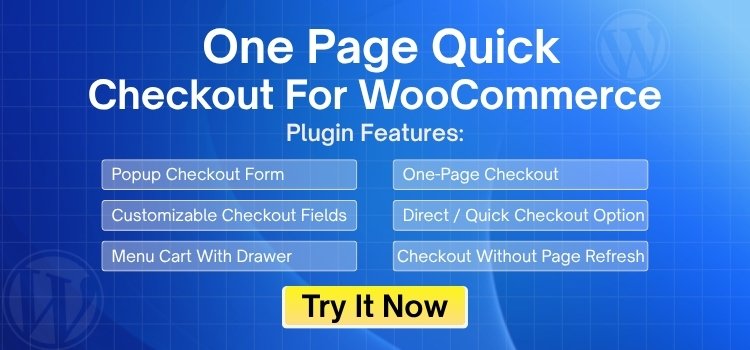Nowadays, WooCommerce shops are popular for powering online businesses of all sizes, making shopping convenient and efficient. However, one of the most important aspects of any WooCommerce store is the checkout process, which can significantly impact sales and customer satisfaction. There are two main types of checkout: one-step and multi-step. This brings up a common question among store owners: One-Step vs Multi-Step Checkout: Which Is Better for WooCommerce?
One-Step Checkout offers speed and simplicity, ideal for fast purchases, while Multi-Step Checkout can reduce cart abandonment by guiding users. The best choice for WooCommerce depends on your products, customer preferences, and the overall user experience you want to create.
Would you like to know more about this topic? If yes, then read on as we break down both options to help you decide.
One-Step vs Multi-Step Checkout: Which Is Better for WooCommerce?
Choosing the right checkout style is crucial for WooCommerce store owners. Your choice affects customer experience and sales. Let’s dive into the difference between One-Step and Multi-Step Checkout and see which works better for your shop.

Speed and Simplicity
One-step checkout lets customers finish their entire order on one page. This means shoppers enter their details, review, and pay without extra clicks. The process is fast, which many buyers love when they want to buy quickly. Many WooCommerce store owners enhance this experience by using options like the direct checkout for WooCommerce plugin to make checkout even smoother.
Multi-step checkout breaks the process into smaller sections across multiple pages. Each step usually asks for a specific piece of information, like shipping or payment details. Some users feel comfortable with this slower pace, especially if they need time to check their order. But others may get tired of clicking “next” too many times.
User Experience
Using a one-step checkout can feel easy and clear for many customers. Everything they need to fill out is visible at once, reducing confusion. This quick process often leaves shoppers feeling satisfied with how smooth it is. When the path to purchase is short, customers are more likely to finish.
Multi-step checkout aims to guide shoppers through the process step by step. This can be helpful for people new to online shopping or with big orders. The clear division of steps can make some users feel more secure. However, too many steps may turn away shoppers who prefer speed.
Cart Abandonment Rates
One-step checkout is designed to help lower cart abandonment. By putting everything on one page, it keeps buyers engaged from start to finish. Less page loading and fewer distractions mean more completed orders. Shoppers are less likely to give up halfway through.
Multi-step checkout can help reduce abandonment if each stage is simple and clear. Users know exactly what information is needed at each point. Good design and progress bars can encourage people to finish. However, some might drop out if the process feels too long.
Mobile Friendliness
Mobile devices are particularly suited to one-step checkout. With fewer pages to load, shoppers can buy products quickly from their phones or tablets. Simple layouts mean less scrolling and less chance of mistakes. This makes it a favorite for stores with lots of mobile traffic.
Multi-step checkout can be more challenging on small screens. Each extra page or click takes more time and effort. If not designed well, it can frustrate users and lead to cart abandonment. Still, clear and short steps can make it work for mobile with some effort.
Customization and Flexibility
Store owners often find one-step checkout easy to customize. You can add or remove fields based on your products and customer needs. This flexibility means you can make checkout as simple as possible. Quick adjustments can help stores respond fast to changing trends.
Multi-step checkout also allows for customization, but it usually requires more setup. Each page can gather detailed information, which is useful for complex sales. Extra options can be added at each stage, if needed. However, too much detail may slow things down for simple orders.
Security and Trust
One-step checkout can sometimes show many fields on a single page, which may worry some customers. To build trust, adding security badges and clear labels helps shoppers feel safe. A clean design without clutter is important for making people feel comfortable. Fast, transparent processes boost confidence in your store.
Multi-step checkout spreads information over several pages, which can feel more secure to some buyers. Sensitive details like payment information are often on the last step. This makes shoppers feel that their data is handled carefully. Showing trust symbols and using short forms can increase security and trust at each stage.
Why the Checkout Experience Matters in E-Commerce?
Checkout is the last step people take when shopping online. This part may seem simple, but it plays a big role. A good or a bad checkout can change a person’s decision in seconds. Here is why it’s so important and how it works:
First Impressions Count
The checkout page is the final place where shoppers decide if they want to buy. If it looks messy or confusing, people may leave without buying. A clean, simple page helps them feel more confident. It shows that the store is trustworthy. People are more likely to finish their order when they feel comfortable.
Speed Matters
Waiting can make online shopping less enjoyable. Many people leave if they feel the checkout is slow or complicated. Fewer clicks and faster checkout performance help shoppers finish their orders without frustration. When stores make this step quick, buyers feel more satisfied. Fast checkouts also help people shop even when they’re in a hurry.
Easy to Use
A good checkout should be easy for anyone to understand. Too many forms or confusing steps can push people away. Simple instructions and clear buttons help a lot. When shoppers know what to do, they’re more likely to finish. Less confusion means more completed orders.
Works on Phones
Many people shop using their phones. So the checkout should work well on small screens too. Big buttons and short forms make it easier to use. If it doesn’t fit or is hard to tap, people might leave. A phone-friendly checkout can bring in more sales.
Safe and Secure
People want to feel safe when giving their card details. If the checkout doesn’t look secure, they won’t trust it. Showing safety signs like lock icons helps build trust. A short message saying “Your info is safe” can also help. Feeling safe makes people more likely to buy.
Simple Design
A checkout with too many colors or ads can be distracting. A clean design helps shoppers focus on finishing their order. Too many pop-ups or offers can slow them down. Keeping things clear and calm works better. The simpler it looks, the better it works.
Who Should Utilize One-Step Checkout?
One-step checkout looks simple, but it can make a big difference for online stores. Some shops may need it more than others, depending on what they sell. It’s not a one-size-fits-all thing, and that’s okay. Let’s see who can really benefit from using it.

Small Online Stores
Small stores usually don’t need a lot of extra steps at checkout. One-step checkout helps them keep things fast and simple. Customers can quickly enter details and place their orders. This is great for shops with fewer products or services. Less hassle means happier buyers.
Stores Selling Fast-Moving Items
If your shop sells items people buy quickly, like snacks or daily goods, one-step checkout works well. It lets people buy fast without wasting time. Shoppers don’t want to fill out long forms for small items. A short, simple checkout keeps them coming back. This setup fits busy shoppers who want quick results.
Mobile-Friendly Shops
Many people shop from their phones, and long checkouts don’t work well on small screens. One-step checkout fits better and loads faster on mobile. It cuts down on tapping and scrolling. This makes shopping easier and less annoying. A smooth mobile checkout helps keep phone users happy.
Stores With Repeat Customers
Some shops have buyers who shop often, like fans of certain brands. These shoppers already trust the store and want a quick way to buy. One-step checkout saves time since they don’t need to go through extra steps. It gives them a smooth, fast experience every time. This helps build loyalty as well.
Stores With Simple Products
If your store sells simple items like t-shirts or phone cases, you don’t need a long checkout. One-step checkout handles it all on one page. There’s no need to collect lots of details or show many options. The faster people can buy, the better it is for your store. It keeps everything short and easy.
Best Plugins for One-Step Checkout in WooCommerce
Using the right plugin can speed up the checkout process in your WooCommerce shop. There are many plugins out there, and each one has its own style. Some plugins keep things simple, while others offer more features. Here are some of the best options and what makes them special.
One Page Quick Checkout for WooCommerce
This plugin makes checkout fast and easy by showing a simple pop-up form. Customers can finish their purchase without reloading the page. It supports one-page checkout with clean layouts and lets you customize fields with images and quantity options. You can also add quick checkout buttons on product pages. It works with popular page builders like Elementor and Gutenberg for easy setup.
CheckoutWC
CheckoutWC changes the look of your WooCommerce checkout. It makes everything fit nicely on one page. The design is easy to use and looks good on phones as well. There are options to add helpful hints for buyers. Stores that want a modern feel often pick this plugin.
Bolt Checkout for WooCommerce
Bolt Checkout is known for its strong security and speed. It keeps the checkout process short and safe for everyone. This plugin also supports many payment methods. Shoppers don’t have to spend much time at the end of their purchase. Stores that care about safety and quick checkouts like using Bolt.
PeachPay
PeachPay gives a super quick way for customers to pay. Shoppers can check out with just a few clicks. The plugin remembers user details for future orders. This makes coming back to shop even easier. Many stores love PeachPay for its speed and repeat-customer features.
Flux Checkout
Flux Checkout changes WooCommerce into a smooth one-step flow. It removes extra fields that are not needed. The design is clear, and it’s simple for people to understand. Stores see fewer abandoned carts when using Flux. Buyers can finish their purchase with less confusion.
YITH WooCommerce One-Click Checkout
YITH makes checkout as easy as clicking a button. With this plugin, returning customers can buy again with just one click. It helps save time and reduces effort for everyone. Stores with lots of repeat buyers find this very useful. Quick checkouts help keep customers coming back.
Is It Easy to Set Up One-Step or Multi-Step Checkout Processes in WooCommerce?
Setting up checkout in WooCommerce isn’t as hard as it may seem at first. You don’t need to be a tech expert. Many themes and plugins offer helpful tools that guide you step by step. Most store owners can do it without needing special skills or extra help.

One-step checkout is quicker to set up for simple stores with fewer products. It often takes less time and fewer settings to adjust. Plugins usually come with easy instructions and ready-to-use layouts for fast setup. This is helpful if you want a clean and simple checkout without extra steps.
Multi-step checkout takes more time, especially for a customized WooCommerce checkout process with more fields or complex product details. You may need to fine-tune each part, like shipping, billing, and payment options. Some plugins offer drag-and-drop tools to make changes easier. With a little patience, even multi-step setups can be done without coding.
Tips to Optimize Your WooCommerce Checkout Process
A smooth checkout can help you get more orders and fewer abandoned carts. Shoppers love it when the process is quick and simple. Here are some helpful tips to make your WooCommerce checkout work better.
- Keep It Short: Long forms can confuse shoppers and make them leave. Remove any unneeded fields to make the checkout faster and easier.
- Use Guest Checkout: Forcing account creation can push people away. Letting them check out as guests saves time and keeps them focused.
- Auto-Fill Details: Make the process faster by using auto-fill for names and addresses. This saves time and lowers the chance of mistakes.
- Show Progress Steps: Clear steps help people know how far they’ve gone. It keeps them calm and less likely to quit midway through.
- Add Trust Signals: Show safety badges or payment logos at checkout. These build trust and help customers feel their data is protected.
- Use Mobile-Friendly Design: Lots of people shop on their phones. A checkout that works well on small screens keeps mobile users from giving up.
- Give Clear Error Messages: When something goes wrong, explain it clearly. People get frustrated when they don’t understand what to fix or do next.
- Offer Fewer Distractions: Remove ads and pop-ups from the checkout page. A clean page helps shoppers focus only on finishing their purchase.
Frequently Asked Questions
Have questions about choosing the best checkout style for your WooCommerce store? You’re not alone! Here are some common questions and answers to help you understand how one-step and multi-step checkouts work, so you can make the best choice for your shop.
Why Do Some Customers Prefer Multi-Step Checkout?
Some buyers feel more secure when checkout is broken into parts. It helps them focus on one thing at a time, like entering shipping or payment info. Multi-step feels more organized for big orders. It gives shoppers time to review everything carefully before paying.
How Can Checkout Forms Be Made Easier to Understand?
Use clear labels, short field names, and helpful notes near each input box. Keep only the fields you truly need. Adding auto-fill and error messages also helps a lot. This makes the form easier and faster for everyone to complete.
What Happens If a Plugin Breaks the Checkout Flow?
When a plugin causes issues, it may block loading or stop payments from going through. This can frustrate buyers and hurt sales. Always test new plugins on a staging site. Check for errors and fix them before going live.
Which Checkout Style Works Best for Mobile Devices?
One-step checkout usually works better on mobile. It loads everything on one page, so users don’t have to tap back and forth. This saves time and avoids confusion. Just make sure it’s mobile-friendly with big buttons and short forms.
What’s the Main Reason for Cart Abandonment During Checkout?
The most common reason is a slow or confusing checkout process. Long forms, surprise costs, or forced account creation turn people away. One-step checkout helps reduce this by keeping things fast. Multi-step works well if designed with care and clarity.
How Can You Track Checkout Performance in WooCommerce?
You can use tools like Google Analytics or WooCommerce-specific reports to monitor drop-off rates, time on page, and conversion data. This helps you understand where users stop and why. Set up event tracking for each action. Then test improvements based on that data.
Which Checkout Type Helps Reduce Decision Fatigue?
One-step checkout can reduce decision fatigue by showing everything in one go. It avoids breaking the process into too many parts. Shoppers don’t feel stuck in an endless cycle of clicking next. That saves mental energy and keeps the focus on buying.
Bottom Line
Choosing the right checkout style might seem like a small step, but it can make a big difference in how people shop at your store. Whether you’re selling simple items or handling large orders, the checkout process is where most decisions happen. A smooth, easy-to-use setup can turn more visitors into happy buyers.
When asking the question one-step vs multi-step checkout: which is better for WooCommerce?, it really depends on your store’s needs and your customers’ habits. One-step checkout works well for speed and mobile shoppers, while multi-step checkout helps with larger or more detailed orders. Both can be effective if set up the right way with the right tools.
Take time to understand your audience and test what works best. A better checkout isn’t just about looks—it helps grow your business with every sale.

